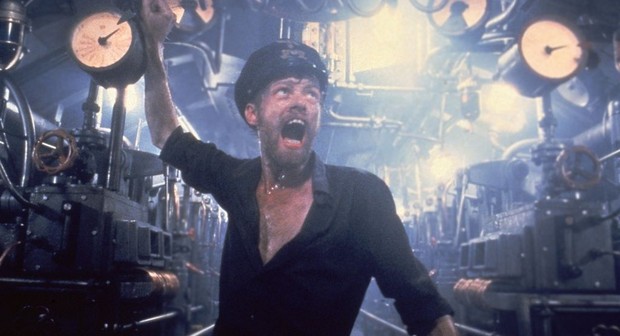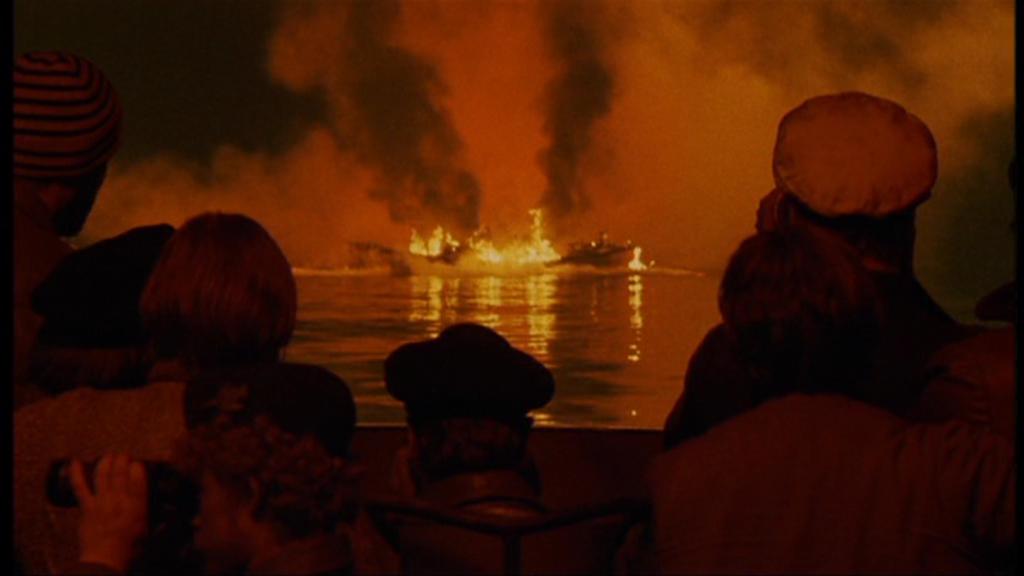Das Boot (1981)

DIRECTOR: Wolfgang Petersen
CAST: Jurgen Prochnow, Herbert Groenemeyer, Hubertus Bengsch, Martin Semmelrogge, Klaus Wennermann, Bernd Tauber, Erwin Leder
REVIEW:
Hailed as possibly the best submarine film ever made, and one of the most honest and unromanticized portrayals of war, Wolfgang Petersen’s simply-titled magnum opus Das Boot (“The Boat” in English) features only adequate special effects and few and far between action sequences, but overcomes any limitations with uniformly authentic performances, Petersen’s direction, and the haunting, sometimes stirring but more often melancholy score by Klaus Doldinger.
Das Boot begins with the information that the Battle of the Atlantic is turning against the Germans, and then the ominous factoid that out of 40,000 German submariners, 30,000 did not survive. Our entry point into the story is young, fresh-faced war correspondent Lt. Werner (Herbert Groenemeyer), assigned to a single tour aboard a U-Boat, who accompanies its experienced Captain (Jurgen Prochnow) to a raucous party in occupied France. During this sequence—one of the only ones to take place on land—we become acquainted with the crew: the war-weary but dedicated Captain, the naive and eager Werner, hoping to bring back a heroic story for the Propaganda Ministry, “The Chief” (Klaus Wennemann), worried about his sickly wife back home, the cheerful 2nd Lieutenant (Martin Semmelrogge), and the stiff 1st Lieutenant (Hubertus Bengsch), the most outspoken Nazi onboard. During the party, a fellow captain (Otto Sander) is led offstage after drunkenly mocking Hitler, although we get the impression that Prochnow’s nameless Captain quietly agrees. Relaxed after their night of revelry, the crew boards their U-Boat and optimistically sets sail. For a time, nothing much happens, to the point where the crew is bored and craving action. They eventually get their wish when they finally get to attack a British convoy, but from that point on they enter into a deadly cat-and-mouse game of attack and counterattack, unable to see the depth charges drifting down from above, and with no choice but to place their lives in the hands of their capable but not infallible Captain.

Though Herbert Groenemeyer—a popular German singer and musician, acquitting himself convincingly in one of his few acting roles—provides our entry point into the story and a convenient plot device giving the Captain an organic reason to explain things for the benefit of the audience, Lt. Werner is largely a passive observer, sitting back and observing his crewmates (the character is a loose stand-in for Lothar-Gunther Buchheim, whose novel based on his wartime exploits provided the basis for the movie). The real glue holding Das Boot together is veteran German actor Jurgen Prochnow as the wily, brave, and compassionate—as much as circumstances will allow—Captain who keeps his cool in the most desperate of situations, demanding reports even as the ship is on the verge of breaking apart. By design, this is not the stuff of deep character development, but the Captain gets a few touches: he is a thirty-year sea veteran, he has grown bitter and cynical about the way the war is being fought and expresses disdain for the bigwigs and their “brilliant strategy” (Petersen throws in a pointed shot of a cockroach crawling over a framed photograph of Admiral Doenitz), and admits his displeasure to Werner about the young age of his crewmen, complaining that he feels like he is on a “children’s crusade”. We have a passing familiarity with some of the other characters—the ardent Nazi 1st Lieutenant raised in Mexico in a wealthy German colonial family and the only crew member who keeps up with shaving and wearing his full uniform, the Austrian chief mechanic on the verge of a breakdown, a young man longing for a reunion with his pregnant French girlfriend and worried she’ll be condemned by her countrymen as a traitor if Germany loses the war—but this is more the story of the sub itself than any individual character. Like its Captain, Das Boot takes a mostly apolitical angle; with the exception of the 1st Lieutenant, no one onboard expresses much in the way of political beliefs—in fact, it’s implied the Captain has no love for the Nazi Party—and no swastika is ever clearly displayed onscreen. Petersen obviously intends the audience to simply view the crew as sailors sent to war, regardless of which side they may be fighting for.
The most expensive German production of its time, much of Das Boot‘s budget was spent on constructing a full-sized seagoing submarine, and a full-size model for exterior shots. Such was Petersen’s striving for authenticity that the original constructors were used; it was their first assignment since WWII. Three scale models were built for special effects work. The first, a thirty-five foot remote-controlled model, could sail in high seas and dive. The other two, eighteen and eight feet in length, respectively, were used for underwater shots. Scale models of tankers, destroyers, and other ships were also built to complete the armada. To help his actors convey the conditions found on a real U-Boat, Petersen insisted on filming within the actual confines of the sub—scarcely wider than a man’s outstretched arms—rather than removing the model’s outer wall, enhancing the audience’s ability to feel the claustrophobia the crew felt in their long voyages beneath the waves. The full-size model used in the film can still be seen to this day, at Bavaria Film Studios in Munich. When the film was first released in the United States, it ran 145 minutes and won both popular and critical acclaim and six Oscar nominations, unheard of for a foreign film. A 1997 director’s cut added significant deleted scenes back into the mix, expanding the runtime to 210 minutes and adding more substantial character development for many side characters.

When it comes to war, Das Boot has not a shred of interest in any romanticizing. Having evaded a trio of destroyers crisscrossing above dropping depth charges, the sub finally surfaces to deliver the coup de grace: a final torpedo to a burning tanker. As the ship goes down in flames, the Germans are disturbed to see men still leaping from its deck or in the burning water. In some ways, submarine versus destroyer can feel like a “clean”, detached form of warfare, never seeing the enemy they’re destroying, but it’s another matter to suddenly come face-to-face with the ramifications of their actions. Some of the drowning men try to swim toward the U-Boat, their pleas for help echoing across the water, but while some of his younger, less battle-hardened crewmen are clearly distraught, the Captain is neither willing nor able to accommodate enemy prisoners onboard his cramped boat, and orders his submarine to reverse away from them. How does he really feel about his actions? He keeps his opinions to himself. It’s hard to imagine an American war movie including a scene in which American submariners are shown allowing drowning men to die, but Das Boot is a German movie, made by the losers of a war long after the fact, with no flag-waving.
Throughout its runtime, Das Boot strives to disprove Francois Truffaut’s assertion that it is impossible to make an anti-war film, because films inevitably make war look exciting. Das Boot depicts submarine warfare as long periods of mind-numbing boredom, punctuated by moments of nerve-wracking tension. Apart from the opening party, and a refueling sequence near the end, we never leave the cramped sub. Jost Vacano’s cinematography sends the camera hurtling along with the men down the length of boat from one end to the other, plunging through cramped openings and hurdling over obstacles, ducking under hammocks and swinging light fixtures. An extended sequence in which the sub is trapped at the bottom of the Strait of Gilbraltar and the men lay gasping for dwindling oxygen on their hammocks, feels claustrophobic and suffocating to an uncomfortable extent.
Das Boot is not an action movie, nor is it a happy one. But for viewers seeking a perspective of WWII from the “other side”, or just warfare in general without any Hollywoodized gloss or romanticism, one is likely to go away feeling satisfied, if not uplifted.
* * * 1/2